Dearden Surname Ancestry ResultsOur indexes 1000-1999 include entries for the spelling 'dearden'. In the period you have requested, we have the following 271 records (displaying 191 to 200): Single Surname Subscription | | | Buying all 271 results of this search individually would cost £1,516.00. But you can have free access to all 271 records for a year, to view, to save and print, for £100. Save £1,416.00. More... |
These sample scans are from the original record. You will get scans of the full pages or articles where the surname you searched for has been found. Your web browser may prevent the sample windows from opening; in this case please change your browser settings to allow pop-up windows from this site. Anglicans in Salford and their children
(1891)
The parish magazine of the populous Anglican parish of Salford St Matthias contains not only parish news and notices, but also lists of Baptisms, Marriages and Deaths. The parish was divided into 38 districts for the Christian Workers' Association, and the districts are listed, with the names of the streets, and the names and addresses of the district visitors. The Sunday School prize lists give the names of many of the children, arranged by class; and there is a long prize list for the year for boys and girls attending the Anglican day and infants schools at Broughton Road and Silk Street. The parish comprised Broughton Road, St Simon's Street, Back Sandon Street, Wood's Buildings, Sandford Street, Watkin Street, Harriet Street, Brougham Street, Wheat Hill Street, Rose Street, Pink Street, Silk Street and Back Silk Street, Adelphi Street, Flax Street, Ann Street, Diamond Street, Lester Street, Cliburn Street, Sagar Street and Back Sagar Street, Pine Street, Matthew's Buildings, Blackburn Street, Blackburn Place, North James Henry Street, Pea Street, Cannon Court, Arlington Street and Back Arlington Street, Silk Place, Russell Street, Artillery Street, Gun Street, Bow Street, Chestnut Street, North Charles Street, Peter Street, North Thomas Street, Ogden Street, North Cable Street, Cannon Street, Rockville Street, Barnet Street, Brook Street, McIntyre Square, Burton Street, Devine Street, Methvin Street, Skellorn Street, North Hill Street, Briggs Street, Simms Street, Allendale Street, Francis Terrace, Marshall Terrace, Albert Terrace, North George Street, Alexander Street, Albert Street, Marshall Street, Mount Street, Mayers Street, Peru Street, Reservoir Terrace, John Street, Richmond Terrace, Richmond Row and Back Richmond Row, Ford Lane, Ford Land View, Richmond Hill, High Holborn Terrace, Perseverance Place, Williamson Street, Willow Street, and Salford Street.DEARDEN. Cost: £6.00.  | Sample scan, click to enlarge

| Boys entering Uppingham School
(1891)
The public school at Uppingham in Rutland was founded by Archdeacon Johnson in 1584. A roll of scholars from 1824 to 1905 was edited by J. P. Graham, and published in 1906. This was a revision and updating of an 1894 edition of the roll, the great bulk of the work having been done by Mrs Mullins. The roll is arranged by year, and within each year by term of entrance, and then alphabetically by surname within each term. Each boy's name is given, surname first, with an asterisk where known (in 1906) to have died. Then there is month and year of birth, father's name (most often just surname and initials) and address (at entrance). Where the boy represented the school at Rugby football (XV) or cricket (XI), that is indicated. After the month and year of leaving the school, there is a brief summary of achievements in later life, and, where known, address as in 1906. From 1875 onwards the house within the school is also noted, with these abbreviations: A., Mr Constable's House; B., Brooklands; C., West Bank; E., Mr J. Gale Thring's House; F., Fircroft; Fgh., Farleigh; H., Highfield; L., The Lodge; L. H., Lorne House; M., Meadhurst; N., The Hall; R., Redgate; R. H., Red House; S., School House; and W. D., West Deyne.DEARDEN. Cost: £4.00.  | Sample scan, click to enlarge
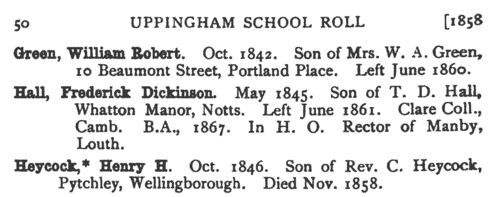
| Clergy on the committees of the Anglican Church Congress
(1892)
The 32nd annual congress of the Anglican church was held at Folkestone on the 4th, 5th, 6th and 7th October 1892. Moral and social questions were discussed as well as the purely theological and ecclesiastical - The Relation between the Authority of the Bible and the Authority of the Church; the Attitude of the Church towards Labour Combinations; the Work of the Church of England on the Continent; the Result of the Neglect of Religious Instruction in Elementary Schools; Canon Law; the Duty of the Church to the Agricultural Population; Christian Ethics; Meeting of Women; the Temperance Movement; Physical Recreation; the Permanent Value of the Old Testament; Thrift and the Poor Law; Vivisection; Preparation for Clerical Orders, and of Laymen for Evangelism; Foreign Missions; the Duty of the Church towards Soldiers; Christian Doctrine and Christian Life; Preaching in the Church of England; and the Church's Work at the Seaside. The sermons, letters, addresses and discussions (of clergy and laity) were all published in this, the official report of the congress. The report also included lists of the members of the committees, divided into clergy and laity: this is the index to the clergy.DEARDEN. Cost: £6.00.  | Sample scan, click to enlarge

| Guarantors of the Anglican Church Congress
(1892)
The 32nd annual congress of the Anglican church was held at Folkestone on the 4th, 5th, 6th and 7th October 1892. Moral and social questions were discussed as well as the purely theological and ecclesiastical - The Relation between the Authority of the Bible and the Authority of the Church; the Attitude of the Church towards Labour Combinations; the Work of the Church of England on the Continent; the Result of the Neglect of Religious Instruction in Elementary Schools; Canon Law; the Duty of the Church to the Agricultural Population; Christian Ethics; Meeting of Women; the Temperance Movement; Physical Recreation; the Permanent Value of the Old Testament; Thrift and the Poor Law; Vivisection; Preparation for Clerical Orders, and of Laymen for Evangelism; Foreign Missions; the Duty of the Church towards Soldiers; Christian Doctrine and Christian Life; Preaching in the Church of England; and the Church's Work at the Seaside. The sermons, letters, addresses and discussions (of clergy and laity) were all published in this, the official report of the congress. The congress cost £1,822 14s 1d to hold; the receipts were £1,547 18s 5d, leaving a deficiency of £274 15s 8d, which was raised by call on the guarantors. The full list of the guarantors (who had each pledged from 10s to £200 beforehand) was printed in the official report, and this, together with the names of a handful of donors, is indexed here.DEARDEN. Cost: £6.00.  | Sample scan, click to enlarge

| Boys entering King William's College, Isle of Man
(1894)
King William's College at Castletown on the Isle of Man was established in 1830. By 1928 about 290 boys were being educated there, 'of whom three-fourths are boarders, and the remainders sons of natives or residents in the Island.' Boys entered the junior school about 9 or 10 years of age, the upper school about 13; boys over 13 were not admitted 'unless attainments and character are specially satisfactory'. There were 'several nominations for the sons of clergy and others'.
Editions of the college register were published in 1905 and 1927. When this third edition was prepared, in 1956, it was felt unnecessary to repeat the whole of the register from 1830 onwards, a new starting point being chosen as September 1886, when the reverend Frank Bridgman Walters took office as principal.
The items are arranged alphabetically within term of entry; surname is given first, in bold, and then full christian names; then, to the right, in bold, precise date of birth, school house, and month of leaving the school. The abbreviations for houses are: C, Colbourne; D, Dickson; H, Hunt; Ha, Hangoside; J, Junior House; R, Raglan; S, School House (formerly Principal's); T, town houses occupied by masters who took in boys prior to September 1889; Tr, Trafford's; W, Walters.
Each entry then gives the boy's father's name (surname and initials) and address at that time; school honours (such as Prae., praepositor, XI, school cricket team); a career synopsis; and finally, in italics, to the right, year of death, or present address in 1956, if known.DEARDEN. Cost: £4.00.  | Sample scan, click to enlarge
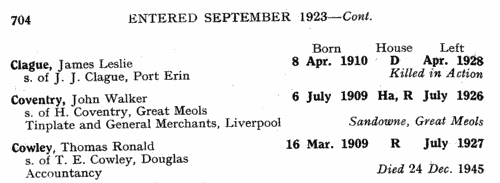
| Steam Engine Makers in England
(1898)
The report of the Steam Engine Makers Society includes accounts of disbursements by all their branches (mostly in England), covering members' sickness, travel and funeral expenses.DEARDEN. Cost: £6.00.  | Sample scan, click to enlarge
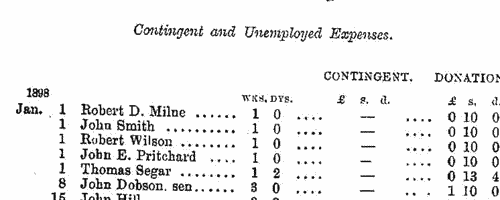
| Eminent Lancashire Medical Men
(1903)
The Contemporary Biography in 'Lancashire at the Opening of the Twentieth Century' was edited by William Thomas Pike. After opening with the most eminent men in the county, there are twelve sections, dealing with Nobility, Gentry and Magistrates; Clergy; Volunteers; Medical Men; the Legal Profession; Art, Music, Literary and Scholastic; Commercial; Dental; Architects, Engineers and Surveyors; Accountants, Auctioneers, Estate Agents, Insurance, &c.; Veterinary Surgeons; and an Obituary. Each biography usually (but not invariably) has a photograph; full name (surname first, in bold; christian name(s) in capitals) and address; birth place and date; father's name (and sometimes details); a short biography; whether married, with wife's name and her father's name and address.DEARDEN. Cost: £4.00.  | Sample scan, click to enlarge
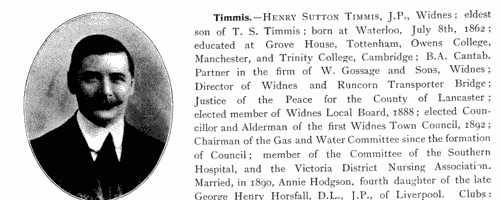
| Associate Members of the Institution of Civil Engineers
(1904)
The Institution of Civil Engineers was established 2 January 1818, and incorporated by royal charter 3 June 1828. The annual report lists the names and addresses (throughout the world) of the four classes of member - members (M. Inst. C. E.), associate members (Assoc. M. Inst. C. E.), associates (Assoc. Inst. C. E.), students (Stud. Inst. C. E.) - with the dates of admission. This is the index to the Associate Members. The symbols at the left of each page are * for Former Students, + for contributors of papers published in the Minutes of Proceedings, or of an Engineering Conference Note; F for a deliverer of a James Forrest Lecture; L for a deliverer of one of the Special Series of Lectures; and various letters for recipients of certain medals and prizes - B, Bayliss Prize; C, Crampton Prize; f, James Forrest Medal; H, Howard Quinquennial Prize; J, Joule Medal; M, Miller Scholarship; m, Miller Prize; italic m, Manby Premium; S, George Stephenson Medal or Prize; T, Telford Premium; t, Telford Premium; italic t, Trevithick Premium; and W, Watt Medal. Those elected prior to 2 December 1878 had been transferred into this class by the Council.DEARDEN. Cost: £6.00.  | Sample scan, click to enlarge
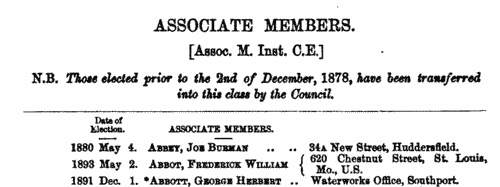
| Ordinary Members of the Institute of Bankers
(1904)
The Journal of the Institute of Bankers for 1904 includes a list of Fellows (from which this scan is taken: an asterisk indicates a Life Fellow), of Associates (an asterisk indicates a Life Associate, and a dagger a holder of the certificate of the institute), and of Ordinary Members; there are also results of the institute's final examinations held from 11 to 13 April, in which the successful candidates are listed alphabetically by surname and full christian name(s), with the name and address of their bank (not their personal addresses). These final examinations entitled the successful candidates to the Certificate of the Institute of Bankers; those who obtained distinctions are so indicated in the lists (an asterisk for Commercial Law, dagger for Arithmetic and Algebra, double dagger for Practical Banking, double s for Commercial Geography and History, and double vertical line for Political Economy). There was also an examination taken after the Gilbart Lectures, with successful candidates being awarded money prizes, or certificates of distinction, or honour, or merit, and similar lists of these awards were also printed in the journal.DEARDEN. Cost: £6.00.  | Sample scan, click to enlarge

| Boys entering Manchester Grammar School
(1907)
This Biographical Register of Old Mancunians lists boys alphabetically by year of entering the school. A bare register of entrants existed from 1888 onwards but it was only since the Second World War that any kind of detailed record was kept of those who passed through the school. So, in every case in this printed register, full name is given, in bold, surname first (in capitals); date of birth, and years attending the school; but for the earlier years sometimes there is no more information - or, equally, after investigation among Old Mancunians and published sources, the editors may have been able to furnish a condensed biography. An asterisk indicates a holder of a Foundation Scholarship. In the later years a current address is also given, as of 1964 to 1965, when the book was prepared.DEARDEN. Cost: £4.00.  | Sample scan, click to enlarge
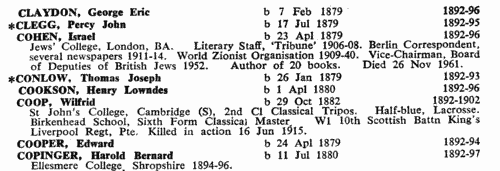
|
Research your ancestry, family history, genealogy and one-name study by direct access to original records and archives indexed by surname.
|












